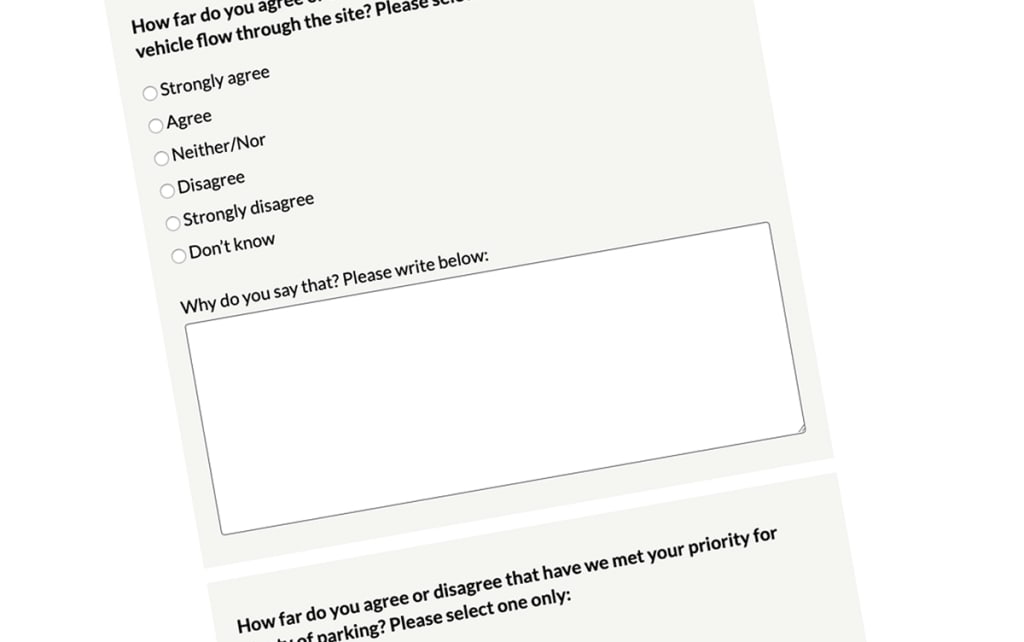
Citizen Space is a powerful, flexible tool that allows you to create beautiful, bespoke consultations to suit whichever topic you like. But it’s not as simple as a list of ‘yes/no’ questions (although those are important in the right context.)
Good question design is a fundamental aspect of producing successful consultations. Ensuring your questions are as relevant, well-formatted and incisive as possible will help to create user friendly consultations which extract useful data.
Your wording should be clear so questions can be interpreted the same way by respondents regardless of background, education level or digital fluency. Explain questions and references where required as informed respondents provide you with answers which can effectively inform decision making.
Below are some example of good and bad question design.
| This | Not This | Why |
| How do you rate our product? | How do you rate our product and service? | Double-barrelled questions only allow one response to two queries and are difficult to analyse |
| Please rate the changes to the service | Please rate the improvements to the service | It’s important to keep questions neutral so respondents don’t feel restricted in their answer |
| What do you have for breakfast? | What do you have for breakfast every day? | Making assumptions in questions can limit the number of respondents who feel able to answer |
| Any further comments relating to this section? | Any further comments regarding this consultation? | Avoiding ambiguity in questions will help respondents feel confident they know what you’re asking |
| Do you approve of the changes proposed? Please choose from the options below | Do you approve of the changes proposed? Please answer in the box below | Asking a quantitative question using a qualitative answer component results in data that is hard to analyse. Consider separating questions like this with two answer components |
| How could the council communicate more effectively with residents? | How could the RCT better implement their public outreach campaign? | Avoid jargon or unnecessary acronyms as it’s likely to confuse and alienate respondents |
Choosing the correct question type

Quantitative
A close-ended question, which asks the respondent to choose the answer most appropriate to them from a set list of options. Quantitative questions will typically provide a good basic understanding of what respondents think but aren’t able to provide any context. This also makes them easier to analyse, as the various options can be graphed and easily broken down.
Qualitative
An open-ended question is one that allows respondents to formulate an answer on their own terms. As a result, a qualitative question can uncover more about why a person holds a particular opinion. Open-ended questions do allow respondents to interpret the question in their own way and can result in answers that wander off topic, so providing prompts and information is important to try to keep them on track.
Top tip: Often the best solution is to utilise a combination of both question types, using a quantitative answer component with an additional free text box prompting a qualitative expansion on their answer.
Required
Too many required questions can alienate your respondents. Identify in the planning stage what you need from the data to be required and leave the rest as optional questions.
Using the appropriate answer components
Choosing the appropriate answer components is an important step in creating a user friendly consultation. Used effectively they can help to:
- Make a questions structure feel familiar to respondents
- Give respondents a level of comfort when answering
- Provide information relevant to a specific question
- Determine the type of data your questions will extract
In summary
Ask yourself when formulating questions:
- Are your questions as clear and concise enough for all respondents to understand?
- Have you provided supporting documentation and explanations so that respondents can provide informed responses?
- Have you used neutral language to avoid biased or leading questions?
- Have you chosen the right type of question and answer component(s) to extract the data you’re after?
If you can keep these basic rules in mind then you should be on the way to a consultation with a smooth and simple respondent journey and one that creates valuable data for you to analyse.
Citizen Space is a citizen engagement platform trusted by government around the world. Government organisations and public bodies use Citizen Space to connect with more citizens, increase engagement and improve processes.
To learn more about what Citizen Space can do for your organisation, book a free demo and we’ll walk you through it.